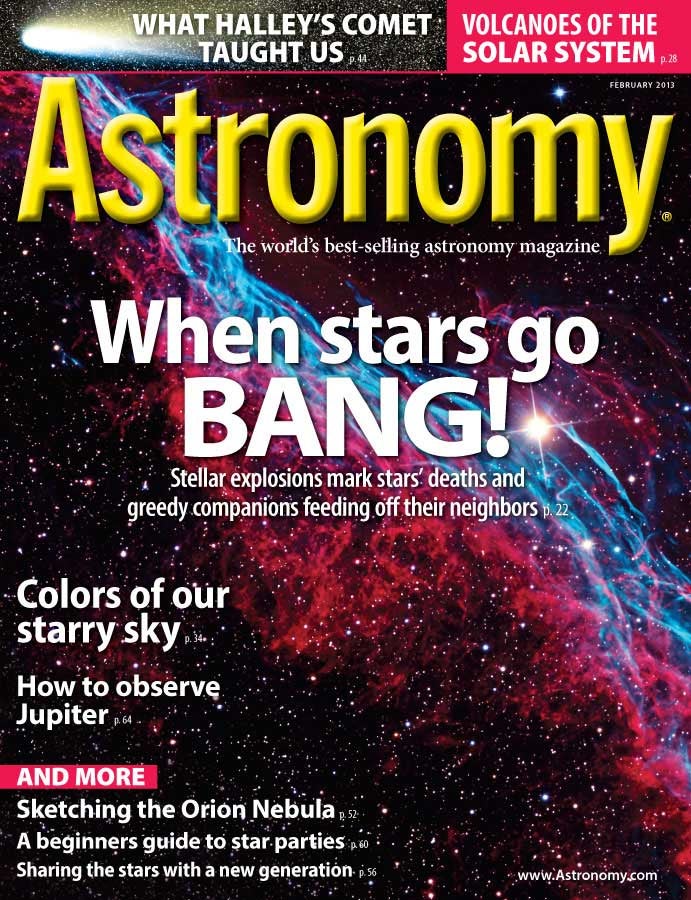
Waukesha, Wis. — Some explosions signal greedy stars stealing material from a companion; others indicate two compact stellar corpses — like black holes — colliding. Astronomers can tell which event led to a specific blast by analyzing the explosion’s light and scouring old data. In “When stars go bang!” science writer Francis Reddy describes the differences between these explosions and the objects that generated them.
With advanced sky surveys, scientists are now spotting more supernovae and observing them right from their initial appearance. So they’re gathering more information about how the brightness of these objects change, and thus the processes that drive that change. “Nearby supernovae also provide the best chance for catching the explosions long before they reach peak brightness in order to better understand how they unfold,” explains Reddy. He explores this evolving research and also touches on the universe’s brightest blasts — gamma-ray bursts.
Read more about these different stellar explosions in the February 2013 issue of Astronomy magazine, on newsstands January 1.
“Tour our fiery solar system”
Many planets and moons in our solar system host volcanic structures, from molten rock on Earth and Jupiter’s Io to frozen-liquid volcanoes on Saturn’s Enceladus and Neptune’s Triton. Evidence of past volcanic activity lies on the Moon, Mars, Venus, and Mercury in addition to other worlds. Explore these vast structures in Senior Editor Richard Talcott’s “Tour our fiery solar system,” and learn how these extraterrestrial volcanoes help scientists better understand the ones close to home.
“Colors of our starry sky”
Why are some stars blue, while others are yellow, and still others appear red? Assistant Editor Karri Ferron explains how stellar color depends on temperature, like glowing coals in a campfire, in the heavily illustrated “Colors of our starry sky.”
“A beginners guide to star parties”
Have you wanted to attend a star party but been too nervous to go because of a fear of not knowing all the “ins” and “outs”? Then read tips from experienced stargazer Karen Jennings in “A beginners guide to star parties.” You’ll find that these groups of amateur astronomers are excited to involve others in the festivities, and chances are you will become a better observer from attending.
February night-sky events visible without optical aid
- February 11 — The Moon passes 5° north of Mercury.
- February 17 — The Moon lies near magnitude –2.4 Jupiter.
- February 18 — Mercury shines at magnitude –0.1, its best in the evening sky for 2013.
Also in the February 2013 Astronomy
- “What Halley’s Comet taught us” — For more than 2,000 years, humanity has been fascinated by this famous comet. Find out why scientists, too, consider it an object worthy of scrutiny.
- “Sketching the Orion Nebula” — Recording the sky’s most famous nebula with pencil and paper unlocks its hidden secrets.
- “Sharing the stars with a new generation” — A variety of groups are revealing the beauty of the universe to the public.
- “How to observe Jupiter” — Next to the Moon, Jupiter has the most visible features of any nighttime object. Why not point your scope at it tonight?
- “The Sky this Month” — Exclusive star charts will guide you through the night sky.
- The February issue of Astronomy also includes Snapshot, Breakthrough, Astro News, Bob Berman’s Strange Universe, Stephen James O’Meara’s Secret Sky, Glenn Chaple’s Observing Basics, Tony Hallas’ Cosmic Imaging, Erika Rix’s Astro Sketching, Ask Astro, Cosmic World, Letters, Web Talk, New Products, Reader Gallery, and Final Frontier.









